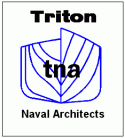services
/ mooring analysis
Dynamic Mooring Analysis
Non-linear dynamic (time domain) mooring analysis
were performed on a number of Oil Rigs and FPSO's as listed below.
1.1 F.P.S.O. Glas Dowr (2003) – Alongside Dynamic
Mooring
1.2 Semi Sub - South Seas Driller (Pride South Seas) – Alongside Dynamic
Mooring
1.3 Semi Sub - Gavea Lifter / Sedco 709 – Alongside Dynamic Mooring
1.4 F.P.S.O Dalia – Alongside Dynamic Mooring
1.5 Semi Sub – Orca – Alongside Dynamic Mooring
1.6 Semi Sub - Atlantic Venture – Alongside Dynamic Mooring
1.7 Semi Sub - Transocean Richardson – Alongside Dynamic Mooring
1.8 Semi Sub – Scarabeo – Alongside Dynamic Mooring
1.9 FPSO - Glas Dowr – Alongside Dynamic Mooring (2009)
1.10 Semi Sub - Sedex 701 – Alongside Dynamic Mooring (2009)
1.11 Jack Up - Hercules 185 – Alongside Dynamic Mooring (2009)
1.12 Semi Sub - Transocean Celtic Sea – Alongside Dynamic Mooring
– Saldanha Bay (2011)
1.13 CALM Buoy – 8 Point Offshore Dynamic Catenary Mooring PetroSA
(2012)
1.14 Semi Sub ORCA Alongside Dynamic Mooring (Coega) (2013)
1.15 Scarabeo 7 (A Berth Cape Town) (2013)
1.16 Semi Sub Ensco E3001 - – Alongside Dynamic Mooring Cape Town
(2014)
1.17 Dhirubhai Deepwater KG1 Drillship – Alongside Dynamic Mooring
(2014)
1.18 Qurban Abasov 8 Point Catenary Mooring – Caspian Sea – standing
off and gangway connected to a BP Platform (2014)
1.19 Transocean Marianas – Alongside Dynamic Mooring Coega (2015)
1.20 Maersk Deliverer – Alongside Dynamic Mooring Coega – (2015)
1.21 Semi Sub ORCA – Offshore Dynamic 9 Point Catenary Mooring at
Mossel Bay – (2015)
1.22 Semi Sub CBC Newbuild – Offshore Dynamic 8 Point Catenary Mooring
in Caspian Sea – (2016)
These were all analyzed for moorings for extended
periods of stay in Cape Town, Walvis Bay, Saldanha Bay, Mossel Bay
and lastly Caspian Sea and assumed 10yr, 25yr, 50yr and 100yr return
wind and gust speeds, as applicable, or other applicable client supplied
data. Most requiring foreign third party approval. The CALM Buoy is
a permanent mooring off the coast of Mossel Bay / Agulhas. These were
all TIME DOMAIN dynamic analysis, which would then predict peak line
tensions, dynamic bollard reactions, dynamic fender reactions and
displacements off and along the quay. Single line failure analysis
would also be performed, as required by the various approval authorities.
The offshore moorings cases would be analyzed for
compliance against compliant with DNV os-e301_2010-10 and API RP 2SK
and analyzed for both Diffraction Analysis (motions) and in the Time
Domain (for dynamic prediction of mooring line responses and vessel
offsets). ULS (Intact), ALS (Single Line Failure) and Transient Analysis
(dynamic response prediction during line failure) is performed. Statistical
Analysis of time series results are performed according to the requirements
of DNV os-e301_2010-10.
QURBAN ABASOV - Dynamic Mooring in the Caspian
Sea (2014)
This catamaran shaped accommodation and supply vessel,
chartered by BP, to offer crew accommodation and support for their
Central Azari Oil Platform, off Baku in the Caspian Sea, required
stringent dynamic mooring analysis, to ensure compliance for both
Alongside the Platform, for servicing an articulated motion compensated
gangway for crew changes, or whilst standing off, for severe weather
scenarios, each with their own set of minimum requirements. The analysis
being performed to DNV-OS-E301 and API Rp 2SK requirements, and approved
by the BP Houston office.
The 8 point mooring catenary spread made more complex
by the very long, multi section mooring lines, comprising of chain,
wire rope and dyneema fibre arranged in such a way as not to infringe
or make contact with various subsea assets including gas and oil pipe
lines, coupled to severe metocean conditions including 9m Significant
Wave Height conditions (in certain directions). The analysis was performed
as a Hydrodynamic Diffraction Analysis followed by Time Domain Analysis,
using the ANSYS AQWA software suite.
GENERAL FENDER BARGES AND DOCKING FRAMES
Triton has also designed numerous fender barges and
docking frames, customised to the specific quay, so as to maintain
the required fendered distance off the quay. Many of these frames
are semi submersed to allow the semi submerged hull of the rig to
bear directly against the frame which in turn, bears directly against
the quay wall, at that same level.
Triton Naval Architects
No. 8 Foregate Square,
Harbour Rd
Foreshore, Cape Town, SOUTH AFRICA
Tel: +27 21 418 2090 | Fax:
+27 21 425 2722 | Email: triton@triton.co.za
By Triton Naval Architects
 Triton
Naval Architects
Triton
Naval Architects Triton
Naval Architects
Triton
Naval Architects